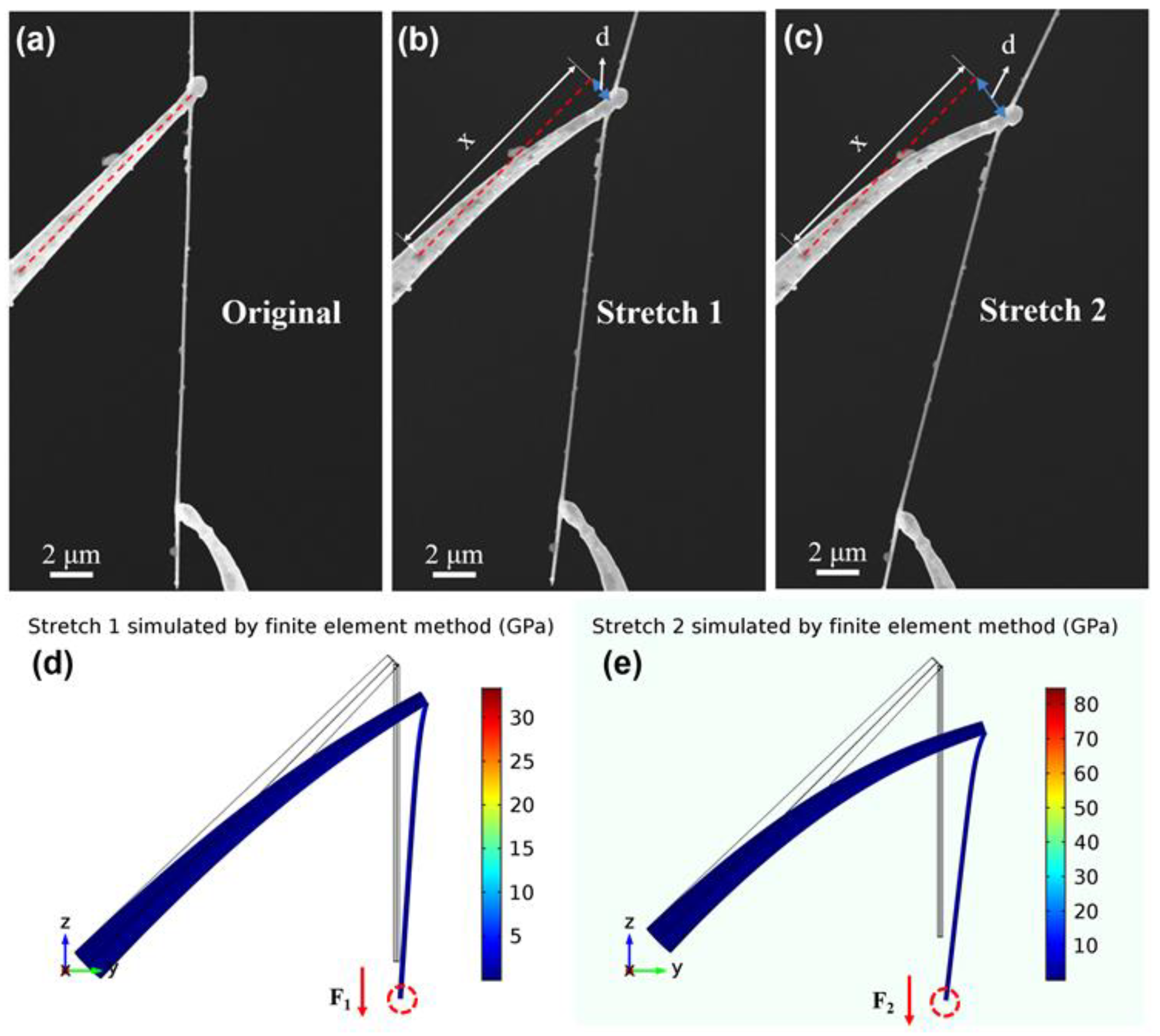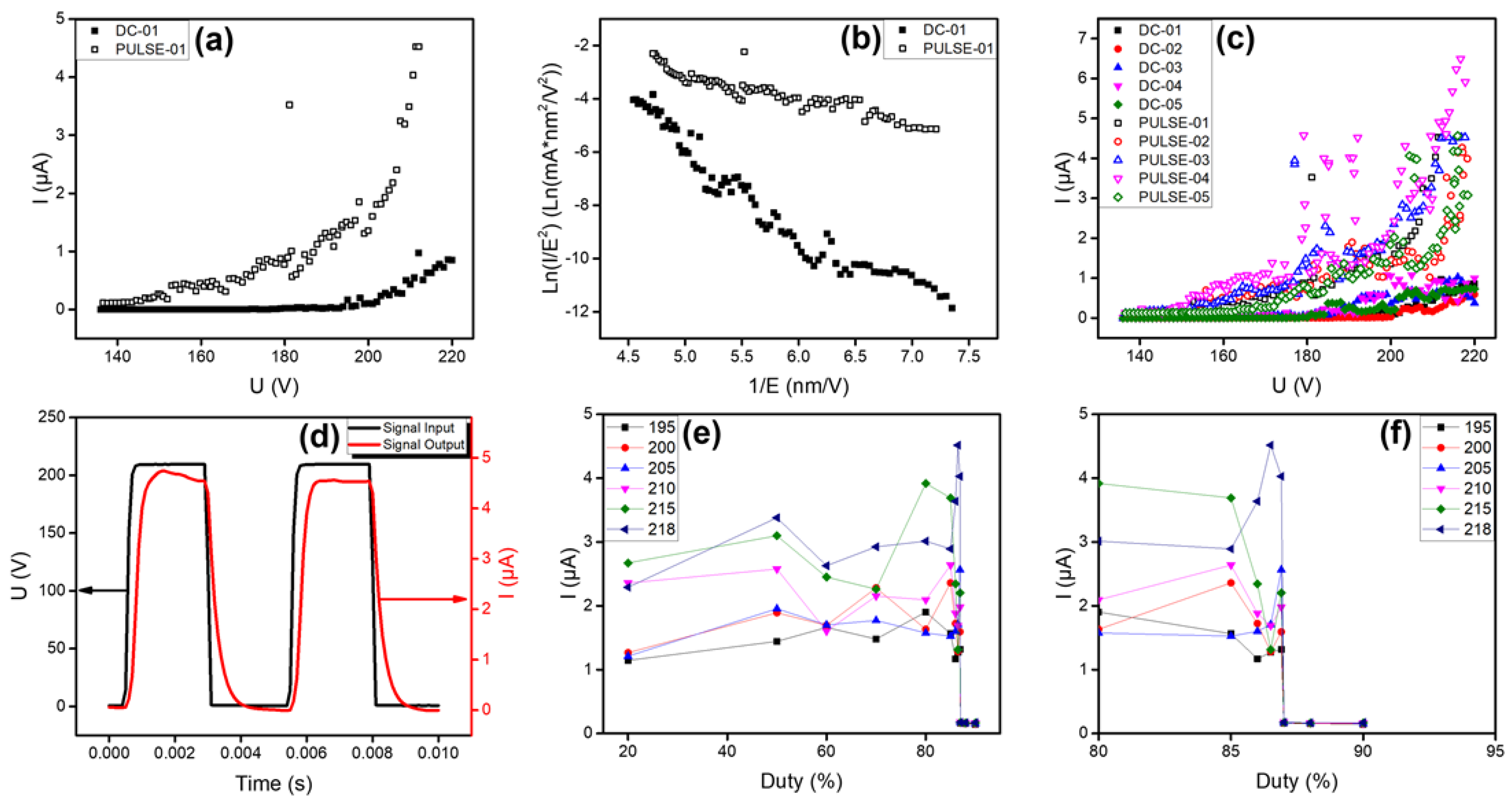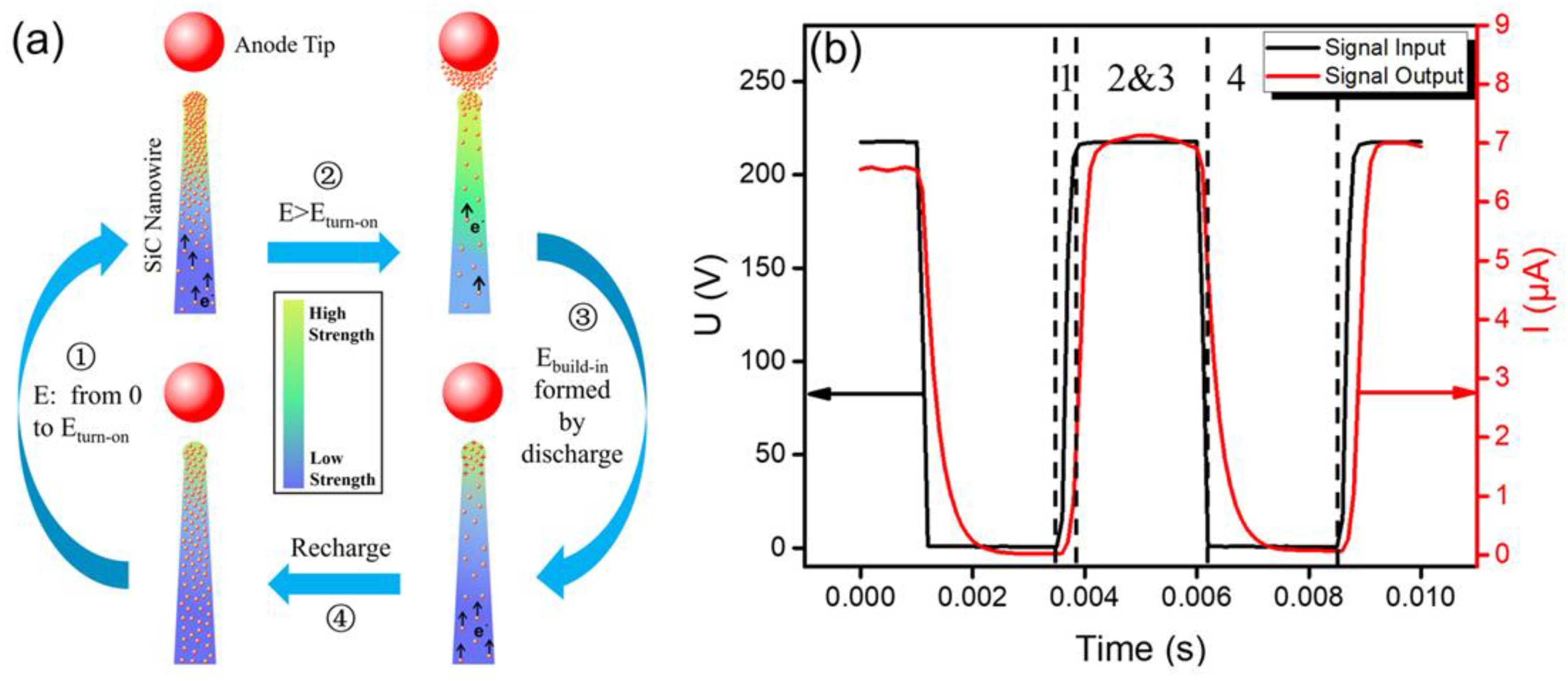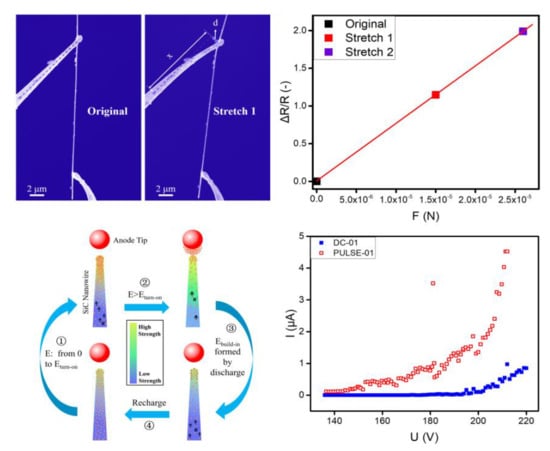Effect of Piezoresistive Behavior on Electron Emission from Individual Silicon Carbide Nanowire
Abstract
1. Introduction
2. Materials and Methods
2.1. Preparation of Individual SiC Nanowires on W Needle
2.2. Morphology and Structure Characterization of SiC Nanowire
2.3. In Situ SEM Electrical Measurement
2.4. Simulation Method
3. Results and Discussion
3.1. Property Analysis and In situ Electric Measurement Scheme for SiC Nanowire
3.2. Piezoresistive Effect of Individual SiC Nanowire
3.3. Electron Emission Behavior of an Individual SiC Nanowire
3.4. Theoretical Analysis of Electronic Transport Behavior for an Individual SiC Nanowire
4. Conclusions
Supplementary Materials
Author Contributions
Funding
Conflicts of Interest
References
- Nguyen, T.K.; Phan, H.P.; Dinh, T.; Foisal, A.R.M.; Nguyen, N.T.; Dao, D.V. High-Temperature Tolerance of The Piezoresistive Effect in p-4H-SiC for Harsh Environment Sensing. J. Mater. Chem. C 2018, 6, 8613–8617. [Google Scholar] [CrossRef]
- Nguyen, T.K.; Phan, H.P.; Han, J.; Dimitrijev, S.; Tanner, P.; Foisal, A.R.M.; Zhu, Y.; Nguyen, N.T.; Dao, D.V. Experimental Investigation of Piezoresistive Effect in p-Type 4H–SiC. IEEE Electron Device Lett. 2017, 38, 955–958. [Google Scholar] [CrossRef]
- Phan, H.P.; Dao, D.V.; Nakamura, K.; Dimitrijev, S.; Nguyen, N.T. The Piezoresistive Effect of SiC for MEMS Sensors at High Temperatures: A Review. J. Microelectromech. Syst. 2015, 24, 1663–1667. [Google Scholar] [CrossRef]
- Okojie, R.S.; Lukco, D.; Nguyen, V.; Savrun, E. 4H-SiC Piezoresistive Pressure Sensors at 800 °C with Observed Sensitivity Recovery. IEEE Electron Device Lett. 2015, 36, 174–176. [Google Scholar] [CrossRef]
- Wu, C.H.; Zorman, C.A.; Mehregany, M. Fabrication and Testing of Bulk Micromachined Silicon Carbide Piezoresistive Pressure Sensors for High Temperature Applications. IEEE Sens. J. 2006, 6, 316–324. [Google Scholar]
- Shor, J.S.; Bemis, L.; Kurtz, A.D. Characterization of Monolithic n-Type 6H-SiC Piezoresistive Sensing Elements. IEEE Trans. Electron Device 1994, 41, 661–665. [Google Scholar] [CrossRef]
- Wu, Z.S.; Deng, S.Z.; Xu, N.S.; Chen, J.; Zhou, J.; Chen, J. Needle-Shaped Silicon Carbide Nanowires: Synthesis and Field Electron Emission Properties. Appl. Phys. Lett. 2002, 80, 3829–3831. [Google Scholar] [CrossRef]
- Wong, K.W.; Zhou, X.T.; Au, F.C.K.; Lai, H.L.; Lee, C.S.; Lee, S.T. Field-Emission Characteristics of SiC Nanowires Prepared by Chemical-Vapor Deposition. Appl. Phys. Lett. 1999, 75, 2918–2920. [Google Scholar] [CrossRef]
- Deng, S.Z.; Li, Z.B.; Wang, W.L.; Xu, N.S.; Zhou, J.; Zheng, X.G.; Xu, H.T.; Chen, J.; She, J.C. Field Emission Study of SiC Nanowires/Nanorods Directly Grown on SiC Ceramic Substrate. Appl. Phys. Lett. 2006, 89, 023118. [Google Scholar] [CrossRef]
- Kim, D.W.; Choi, Y.J.; Choi, K.J.; Park, J.G.; Park, J.H.; Pimenov, S.M.; Frolov, V.D.; Abanshin, N.P.; Gorfinkel, B.I.; Rossukanyi, N.M.; et al. Stable Field Emission Performance of SiC-Nanowire-Based Cathodes. Nanotechnology 2008, 19, 225706. [Google Scholar] [CrossRef]
- Wang, L.; Li, C.M.; Yang, Y.; Chen, S.L.; Gao, F.M.; Wei, G.D.; Yang, W.Y. Large-Scale Growth of Well-Aligned Sic Tower-Like Nanowire Arrays and Their Field Emission Properties. ACS Appl. Mater. Interfaces 2015, 7, 526–533. [Google Scholar] [CrossRef] [PubMed]
- Cui, Y.K.; Chen, J.; Di, Y.S.; Zhang, X.B.; Lei, W. High Performance Field Emission of Silicon Carbide Nanowires and Their Applications in Flexible Field Emission Displays. AIP Adv. 2017, 7, 125219. [Google Scholar] [CrossRef]
- Cheng, X.; Wang, L.; Gao, F.; Yang, W.; Du, Z.; Chen, D.; Chen, S. The N and P Co-Doping-Induced Giant Negative Piezoresistance Behaviors of SiC Nanowires. J. Mater. Chem. C 2019, 7, 3181–3189. [Google Scholar] [CrossRef]
- Phan, H.P.; Dinh, T.; Kozeki, T.; Nguyen, T.K.; Qamar, A.; Namazu, T.; Nguyen, N.T.; Dao, D.V. The Piezoresistive Effect in Top–Down Fabricated p-Type 3C-SiC Nanowires. IEEE Electron Device Lett. 2016, 37, 1029–1032. [Google Scholar] [CrossRef]
- Li, X.; Chen, S.; Ying, P.; Gao, F.; Liu, Q.; Shang, M.; Yang, W. A Giant Negative Piezoresistance Effect in 3C-SiC Nanowires with B Dopants. J. Mater. Chem. C 2016, 4, 6466–6472. [Google Scholar] [CrossRef]
- Bi, J.H.; Wei, G.D.; Wang, L.; Gao, F.M.; Zheng, J.J.; Tang, B.; Yang, W.Y. Highly Sensitive Piezoresistance Behaviors of N-Type 3C-SiC Nanowires. J. Mater. Chem. C 2013, 1, 4514–4517. [Google Scholar] [CrossRef]
- Shao, R.; Zheng, K.; Zhang, Y.; Li, Y.; Zhang, Z.; Han, X. Piezoresistance Behaviors of Ultra-Strained SiC Nanowires. Appl. Phys. Lett. 2012, 101, 233109. [Google Scholar] [CrossRef]
- Gao, F.; Zheng, J.; Wang, M.; Wei, G.; Yang, W. Piezoresistance Behaviors of p-Type 6H-SiC Nanowires. Chem. Commun. 2011, 47, 11993–11995. [Google Scholar] [CrossRef] [PubMed]
- Giubileo, F.; Bartolomeo, A.D.; Iemmo, L.; Luongo, G.; Urban, F. Field Emission from Carbon Nanostructures. Appl. Sci. 2018, 8, 526. [Google Scholar] [CrossRef]
- Xu, N.S.; Huq, S.E. Novel Cold Cathode Materials and Applications. Mater. Sci. Eng. R 2005, 48, 47–189. [Google Scholar] [CrossRef]
- Yang, W.; Wang, W.; Xie, C. Large-Scale Growth of Patterned SiC Nanowire Arrays and Their Field Emission Performance. J. Am. Ceram. Soc. 2019, 102, 3854–3859. [Google Scholar] [CrossRef]
- Chen, S.; Shang, M.; Wang, L.; Yang, Z.; Gao, F.; Zheng, J.; Yang, W. Superior B-Doped SiC Nanowire Flexible Field Emitters: Ultra-Low Turn-On Fields and Robust Stabilities against Harsh Environments. ACS Appl. Mater. Interfaces 2017, 9, 35178–35190. [Google Scholar] [CrossRef] [PubMed]
- Zhang, M.; Li, Z.J.; Zhao, J.; Gong, L.; Meng, A.L.; Liu, X.L.; Fan, X.Y.; Qi, X.L. Amorphous Carbon Coating for Improving The Field Emission Performance of SiC Nanowire Cores. J. Mater. Chem. C 2015, 3, 658–663. [Google Scholar] [CrossRef]
- Li, Y.; Dorozhkin, P.S.; Bando, Y.; Golberg, D. Controllable Modification of SiC Nanowires Encapsulated in BN Nanotubes. Adv. Mater. 2005, 17, 545–549. [Google Scholar] [CrossRef]
- Wang, X.; Tang, B.; Gao, F.; Zheng, J.; Wei, G.; Yang, W. Large-Scale Synthesis of Hydrophobic SiC/C Nanocables with Enhanced Electrical Properties. J. Phys. D Appl. Phys. 2011, 44, 245404. [Google Scholar] [CrossRef]
- Cui, H.; Zhou, J.; Yang, G.Z.; Suna, Y.; Wang, C.X. Growth, Modulation and Electronic Properties of Al2O3-Coatings SiC Nanotubes via Simple Heating Evaporation Process. CrystEngComm 2011, 13, 902–906. [Google Scholar] [CrossRef]
- Seong, H.K.; Choi, H.J.; Lee, J.I.; Choi, D.J.; Lee, S.K. Optical and Electrical Transport Properties in Silicon Carbide Nanowires. Appl. Phys. Lett. 2004, 85, 1256–1258. [Google Scholar] [CrossRef]
- Rogdakis, K.; Lee, S.Y.; Bescond, M.; Lee, S.K.; Bano, E.; Zekentes, K. 3C-Silicon Carbide Nanowire FET: An Experimental and Theoretical Approach. IEEE Trans. Electron. Dev. 2008, 55, 1970–1976. [Google Scholar] [CrossRef]
- Chen, Y.; Zhang, X.; Zhao, Q.; He, L.; Huang, C.; Xie, Z. P-Type 3C-SiC Nanowires and Their Optical and Electrical Transport Properties. Chem. Commun. 2011, 47, 6398–6400. [Google Scholar] [CrossRef]
- Gu, X.; Qiang, Y.; Zhao, Y. Synthesis, Structural and Electrical Properties of SiC Nanowires via a Simple CVD Method. J. Mater. Sci. Mater. Electron. 2012, 23, 1037–1040. [Google Scholar] [CrossRef]
- Cimalla, V.; Rohlig, C.C.; Pezoldt, J.; Niebelschutz, M.; Ambacher, O.; Bruckner, K.; Hein, M.; Weber, J.; Milenkovic, S.; Smith, A.J.; et al. Nanomechanics of Single Crystalline Tungsten Nanowires. J. Nanomater. 2008, 2008, 638947. [Google Scholar] [CrossRef]
- Zhang, T.Y.; Luo, M.; Chan, W.K. Size-dependent surface stress, surface stiffness, and Young’s modulus of hexagonal prism [111] B-SiC nanowires. J. Appl. Phys. 2008, 103, 104308. [Google Scholar] [CrossRef]
- Passacantando, M.; Bussolotti, F.; Santucci, S.; Bartolomeo, A.D.; Giubileo, F.; Iemmo, L.; Cucolo, A.M. Field Emission from a Selected Multiwall Carbon Nanotube. Nanotechnology 2008, 19, 395701. [Google Scholar] [CrossRef] [PubMed]
- Bonard, J.M.; Dean, K.A.; Coll, B.F.; Klinke, C. Field Emission of Individual Carbon Nanotubes in the Scanning Electron Microscope. Phys. Rev. Lett. 2002, 89, 197602. [Google Scholar] [CrossRef] [PubMed]
- Kang, M.G.; Lezec, H.J.; Sharifi, F. Stable field emission from nanoporous silicon carbide. Nanotechnology 2013, 24, 065201. [Google Scholar] [CrossRef] [PubMed]
- Chen, S.L.; Shang, M.H.; Gao, F.M.; Wang, L.; Ying, P.Z.; Yang, W.Y.; Fang, X.S. Extremely Stable Current Emission of P-Doped SiC Flexible Field Emitters. Adv. Sci. 2016, 3, 1500256. [Google Scholar] [CrossRef] [PubMed]
- Poncharal, P.; Wang, Z.L.; Ugarte, D.; Heer, W.A. Electrostatic Deflections and Electromechanical Resonances of Carbon Nanotubes. Science 1999, 283, 1513–1516. [Google Scholar] [CrossRef]
- Chen, Y.C.; Zhao, C.C.; Huang, F.; Zhan, R.Z.; Deng, S.Z.; Xu, N.S.; Chen, J. In Situ Characterization of the Local Work Function along Individual Free Standing Nanowire by Electrostatic Deflection. Sci. Rep. 2016, 6, 21270. [Google Scholar] [CrossRef]
- Purcell, S.T.; Vincent, P.; Journet, C.; Binh, V.T. Tuning of Nanotube Mechanical Resonances by Electric Field Pulling. Phys. Rev. Lett. 2002, 89, 276103. [Google Scholar] [CrossRef]
- Sazonova, V.; Yaish, Y.; Ustunel, H.; Roundy, D.; Arias, T.A.; McEuen, P.L. A Tunable Carbon Nanotube Electromechanical Oscillator. Nature 2004, 431, 284–287. [Google Scholar] [CrossRef]
- Ayari, A.; Vincent, P.; Perisanu, S.; Choueib, M.; Gouttenoire, V.; Bechelany, M.; Cornu, D.; Purcell, S.T. Self-Oscillations in Field Emission Nanowire Mechanical Resonators: A Nanometric dc−ac Conversion. Nano Lett. 2007, 7, 2252–2257. [Google Scholar] [CrossRef] [PubMed]
- Kleshch, V.I.; Obraztsov, A.N.; Obraztsova, E.D. Electromechanical Self-Oscillations of Carbon Nanotube Field Emitter. Carbon 2010, 48, 3895–3900. [Google Scholar] [CrossRef]
- Cumings, J.; Collins, P.G.; Zettl, A. Peeling and Sharpening Multiwall Nanotubes. Nature 2000, 406, 586. [Google Scholar] [CrossRef] [PubMed]
- Wang, Z.L.; Gao, R.P.; Heer, W.A.; Poncharal, P. In Situ Imaging of Field Emission from Individual Carbon Nanotubes and Their Structural Damage. Appl. Phys. Lett. 2002, 80, 856–858. [Google Scholar] [CrossRef]
- Poncharal, P.; Vincent, P.; Benoit, J.M.; Perisanu, S.; Ayari, A.; Choueib, M.; Purcell, S.T. Field Evaporation Tailoring of Nanotubes and Nanowires. Nanotechnology 2010, 21, 215303. [Google Scholar] [CrossRef] [PubMed]
- Forbes, R.G.; Edgcombe, C.J.; Valdre, U. Some Comments on Models for Field Enhancement. Ultramicroscopy 2003, 95, 57–65. [Google Scholar] [CrossRef]





| Samples | Maximum Current Driven by DC Voltage [μA] | Maximum Current Driven by Pulsed Voltage [μA] | Increment [μA] | Percentage of Increment |
|---|---|---|---|---|
| 1 | 0.97 | 4.52 | 3.55 | 366% |
| 2 | 0.62 | 4.27 | 3.65 | 588% |
| 3 | 1.03 | 4.53 | 3.50 | 339% |
| 4 | 1.07 | 6.49 | 5.42 | 506% |
| 5 | 0.74 | 4.56 | 3.82 | 516% |
© 2019 by the authors. Licensee MDPI, Basel, Switzerland. This article is an open access article distributed under the terms and conditions of the Creative Commons Attribution (CC BY) license (http://creativecommons.org/licenses/by/4.0/).
Share and Cite
Zhao, P.; Zhang, Y.; Tang, S.; Zhan, R.; She, J.; Chen, J.; Xu, N.; Deng, S. Effect of Piezoresistive Behavior on Electron Emission from Individual Silicon Carbide Nanowire. Nanomaterials 2019, 9, 981. https://doi.org/10.3390/nano9070981
Zhao P, Zhang Y, Tang S, Zhan R, She J, Chen J, Xu N, Deng S. Effect of Piezoresistive Behavior on Electron Emission from Individual Silicon Carbide Nanowire. Nanomaterials. 2019; 9(7):981. https://doi.org/10.3390/nano9070981
Chicago/Turabian StyleZhao, Peng, Yu Zhang, Shuai Tang, Runze Zhan, Juncong She, Jun Chen, Ningsheng Xu, and Shaozhi Deng. 2019. "Effect of Piezoresistive Behavior on Electron Emission from Individual Silicon Carbide Nanowire" Nanomaterials 9, no. 7: 981. https://doi.org/10.3390/nano9070981
APA StyleZhao, P., Zhang, Y., Tang, S., Zhan, R., She, J., Chen, J., Xu, N., & Deng, S. (2019). Effect of Piezoresistive Behavior on Electron Emission from Individual Silicon Carbide Nanowire. Nanomaterials, 9(7), 981. https://doi.org/10.3390/nano9070981







